Word 2008 and Pages 3.0: Inconsistent deleting behaviour with selection
Posted by Pierre Igot in: Microsoft, PagesMay 20th, 2008 • 3:21 pm
Here is a simple question. Take the following situation when editing a simple text document:
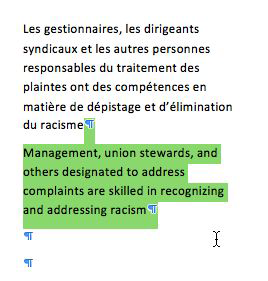
I have a selection that includes the paragraph mark at the end of the first paragraph, the entire second paragraph and the paragraph mark at the end of the second paragraph.
If I now press Delete or Forward Delete, I get the expected result, i.e. Word deletes everything that I had selected:
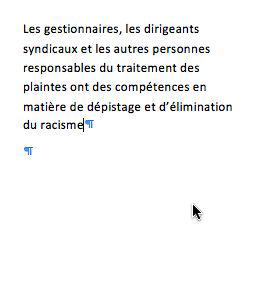
However, if, instead of pressing Delete or Forward Delete, I simply type something—like a period—over the current selection, here is what I get:
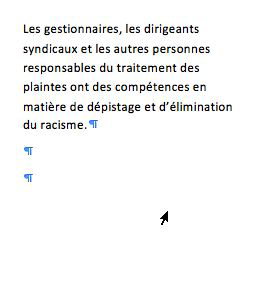
Why did Word leave an extra paragraph mark here? Both paragraph marks were part of the selection, and typing over a selection is supposed to delete that selection.
Yet here Word obviously thinks that it is smarter than me and decides that when I selected this particular range of text, I actually meant to keep one of the paragraph marks that was part of my selection.
Not so. When I selected both paragraph marks before typing, I meant exactly what selecting both paragraph marks should have meant, i.e. I meant to get rid of both of them. There is absolutely no valid reason for Word to assume that the intended behaviour here is different when typing over a selection than when deleting the selection with Delete or Forward Delete.
This inconsistency has probably existed in Word for ages. (I can’t be bothered to check how far back it goes.) Most Word users probably don’t even notice it, because it takes too much time and effort to try and understand each and everyone of Word’s quirks and it is much simpler to just manually delete the extra paragraph after the fact without bothering to wonder why Word did not delete it in the first place.
Unfortunately, there are situations where it is too annoying to ignore, such as text editing in table cells. Here is the same scenario in a table cell. First, a selection that includes the two paragraph marks:
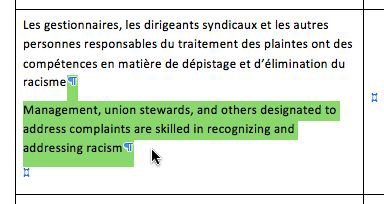
Then the result after pressing Delete or Forward Delete:
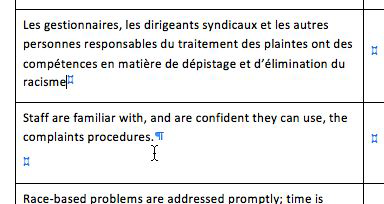
And now the result after typing a simple period over the selection:
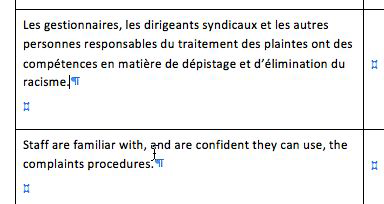
As you can see, the problem here is more significant, because it leaves a trailing paragraph mark in the table cell where there should be none, and that means that the table cell borders do not fit tightly around the cell’s contents.
It is fairly easy to ignore an extra trailing paragraph mark in the body of a document, because there are always extra paragraph marks created through the on-going process of editing the document. But in tables, it has a substantial impact on the visual appearance of the cells—which is where I noticed the inconsistency in the first place, because I was editing table cells and wondering why I kept getting trailing paragraph marks where I expected to get none.
(I actually first thought that this problem was limited to text editing in table cells, because of the unique behaviours generated by the use of a table cell mark instead of a paragraph mark at the end of each cell. But then I checked the behaviour outside a table cell, and it was the same.)
Sadly, I also have to report that Apple’s own Pages 3.0 suffers from the exact same problem, both outside and inside table cells. There is only one difference between Word 2008 and Pages 3.0, which is that, if you type over the selection above and then undo your typing, Pages fails to return to the exact same state: It restores the selection you had highlighted, but without the final paragraph mark.
Here’s the same situation in a Pages 3.0 document:
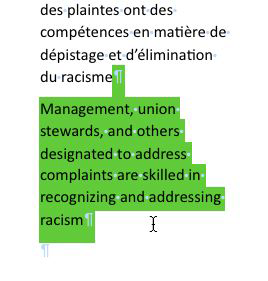
Here’s what happens when you type a period over the selection:
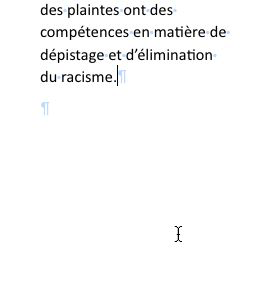
And here’s what you get when you undo the typing:
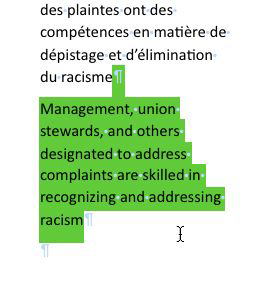
As you can see, the final paragraph mark is no longer selected, even though it was selected before I did the typing that I have just undone. I suppose this additional quirk provides something of a clue as to why Pages, like Word, fails to delete both paragraph marks when you type over the selection.
For some reason, both word processors seem to assume that they know better than you what you want to do. By comparison, BBEdit, in the same situation, does the correct thing and deletes both paragraph marks (return characters in the text editor) both when pressing Delete or Forward Delete and when typing over the selection.
I strongly suspect that this inconsistent behaviour is at least in part due to the fact that both Pages and Word have to try and deal with what happens to paragraph formatting when users delete paragraph marks. Since the formatting of any given paragraph is “stored” inside its final paragraph mark, deleting a paragraph marks has more impact than just deleting a paragraph break or “carriage return”: it actually forces the word processor to decide what formatting the paragraph whose paragraph mark is being deleted is going to “inherit.”
Word processors such as Word or Pages typically try to “guess” what formatting the user actually wants to keep to the best of their abilities. But I don’t really see why this guessing requirement should lead either word processor to fail to delete both selected paragraph marks in the situation above. After all, the first paragraph is going to lose its final paragraph mark anyway. (Needless to say, BBEdit does not have to worry about paragraph formatting.)
To the untrained eye, all this might look like nit-picking. But for people who make a living writing and editing documents in word processors and text editors, and who have become skilled at accurately using text selection tools to select and delete very specific ranges of text, this type of inconsistency can be very annoying.